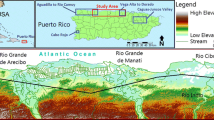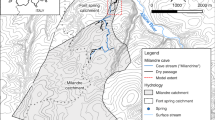Abstract
A karst analog model has been developed for simulating karst aquifer systems with fracture and conduit domains in the laboratory. In this study, sixty-four experiments under different recharging and discharging conditions were carried out with the analog setup to study flow in the karst analog model. The experiments did not only provide hydraulic head data but spring discharge process as well. The experimental results were used to obtain empirical models of water hydraulic head under different hydrological conditions, which together with the spring discharge analysis aided in developing a water hydraulic head prediction model for the analog model. The results showed that water hydraulic head increased with logarithm of time and declined in step-shaped style, which can be used in karst aquifer systems research. Consequently, the study provides useful information for a better understanding of flow in karst aquifer systems.






Similar content being viewed by others
References
Campbell CW, Sullivan SM (2002) Simulating time-varying cave flow and water hydraulic heads using the Storm Water Management Model. Eng Geol 65:133–139
Civita MV (2008) An improved method for delineating source protection zones for karst springs based on analysis of recession curve data. Hydrogeol J 16:855–869
Coppola EA, Rana AJ, Poulton MM, Szidarovszky F, Uhl VW (2005) A neural network model for predicting aquifer water hydraulic head elevations. Ground Water 43:231–241
Criss RE, Winston WE (2003) Hydrograph for small basins following intense storms. Geophys Res Lett 30:1314
Drogue C (1967) Essai de d etermination des composantes de l’ ecoulement des sources karstiques. Chronique d’Hydrog_eologie 10:42–47
Fan Y, Huo X, Hao Y, Liu Y, Wang T, Liu Y, Yeh TJ (2013) An assembled extreme value statistical model of karst spring discharge. J Hydrol 504:57–68
Faulkner J, Hu BX, Kish S, Hua F (2009) Laboratory analog and numerical study of groundwater flow and solute transport in a karst aquifer with conduit and matrix domains. J Contam Hydrol 110:34–44
Feng S, Kang S, Huo Z, Chen S, Mao X (2008) Neural networks to simulate regional ground water hydraulic heads affected by human activities. Ground Water 46:80–90
Ford DC, Ewers RO (1978) The development of limestone caves in the dimensions of length and depth. Can J Earth Sci 15:1783–1798
Ford DC, Williams PW (1989) Karst geomorphology and hydrology. Unwin Hyman, London
Gallegos JJ, Hu BX, Davis H (2013) Simulating flow in karst aquifers at laboratory and sub-regional scales using MODFLOW-CFP. Hydrogeol J 21:1749–1760
Ghasemizadeh R, Hellweger F, Butscher C, Padilla I, Vesper D, Field M, Alshawabkeh A (2012) Review: groundwater flow and transport modeling of karst aquifers, with particular reference to the North Coast Limestone aquifer system of Puerto Rico. Hydrogeol J 20:1441–1461
Jukić D, Denić-Jukić V (2009) Groundwater balance estimation in karst by using a conceptual rainfall–runoff model. J Hydrol 373:302–315
Kiraly L (1998) Modelling karst aquifers by the combined discrete channel and continuum approach. Bull Hydrogeol 16:77–98
Kong-A-Siou L, Cros K, Johannet A, Borrell-Estupina V, Pistre S (2013) KnoX method, or Knowledge eXtraction from neural network model. Case study on the Lez karst aquifer (southern France). J Hydrol 507:19–32
Kurtulus B, Razack M (2007) Evaluation of the ability of an artificial neural network model to simulate the input-output responses of a large karstic aquifer: the la ro chefoucauld aquifer (charente, france). Hydrogeol J 15(2):241–254
Labat D, Ababou R, Mangin A (2000) Rainfall-runoff relations for karstic springs. Part ii: continuous wavelet and discrete orthogonal multiresolution analyses. J Hydrol 238(3):149–178
Lallahem S, Mania J, Hani A, Najjar Y (2005) On the use of neural networks to evaluate groundwater hydraulic heads in fractured media. J Hydrol 307:92–111
Lambrakis N, Stournaras G, Katsanou K, Maramathas A, Lambrakis N (2011) The use of hydrographs in the study of the water regime of the Louros watershed karst formations. In: Lambrakis N, Stournaras G, Katsanou K (eds) Advances in the research of aquatic environment. Springer, Berlin
Liu L, Shu L, Chen X, Wang E, Oromo T (2010) Rainfall-driven spring hydrograph modeling in a karstic water system, Southwestern China. Water Res Manag 24:2689–2701
Nayak PC, Rao YRS, Sudheer KP (2006) Groundwater hydraulic head forecasting in a shallow aquifer using artificial neural network approach. Water Resour Manag 20:77–90
Padilla A, Pulido-Bosch A (1995) Study of hydrographs of karstic aquifers by means of corre- lation and cross-spectral analysis. J Hydrol 168(1):73–89
Peterson EW, Wicks CM (2006) Assessing the importance of conduit geometry and physical parameters in karst systems using the storm water management model (SWMM). J Hydrol 329:294–305
Pochon A, Tripet J, Kozel R, Meylan B, Sinreich M, Zwahlen FO (2008) Groundwater protection in fractured media: a vulnerability-based approach for delineating protection zones in Switzerland. Hydrogeol J 16:1267–1281
Qian J, Zhan H, Wu J, Chen Z (2009) What can be learned from sequential multi-well pumping tests in fracture-karst media? A case study in Zhangji, China. Hydrogeol J 17:1749–1760
Schoeller H (1967) Hydrodynamique dans le karst. Chronique d’Hydrog_eologie 10:7–21
Siemers J, Dreybrodt W (1998) Early development of karst aquifers on percolation networks of fractures in limestone. Water Resour Res 34(3):409–419
Siou LKA, Johannet A, Borrell V, Pistre S (2011) Complexity selection of a neural network model for karst flood forecasting: the case of the lez basin (southern france). J Hydrol 403(3):367–380
Trichakis IC, Nikolos IK, Karatzas GP (2009) Optimal selection of artificial neural network parameters for the prediction of a karstic aquifer’s response. Hydrol Process 23:2956–2969
Trichakis IC, Nikolos IK, Karatzas GP (2011) Artificial neural network (ANN) based modeling for karstic groundwater hydraulic head simulation. Water Resour Manag 25:1143–1152
Tritz S, Guinot V, Jourde H (2011) Modelling the behaviour of a karst system catchment using non-linear hysteretic conceptual model. J Hydrol 397:250–262
White WB (1988) Geomorphology and hydrology of karst terrains. Oxford University Press, New York
Yin D, Shu L, Chen X, Wang Z, Mohammed ME (2011) Assessment of sustainable yield of karst water in Huaibei, China. Water Resour Manag 25:287–300
Acknowledgments
The research work was funded by the National Natural Science Foundation of China entitled ‘The research of groundwater flow in a karst aquifer with conduit-fracture domains’ (No: 41172203) and also supported by innovation projects of universities in Jiangsu Province, 2013 (CXZZ13_0249).
Author information
Authors and Affiliations
Corresponding author
Rights and permissions
About this article
Cite this article
Zhang, C., Shu, L., Appiah-Adjei, E.K. et al. Laboratory simulation of groundwater hydraulic head in a karst aquifer system with conduit and fracture domains. Carbonates Evaporites 31, 329–337 (2016). https://doi.org/10.1007/s13146-015-0274-1
Accepted:
Published:
Issue Date:
DOI: https://doi.org/10.1007/s13146-015-0274-1




